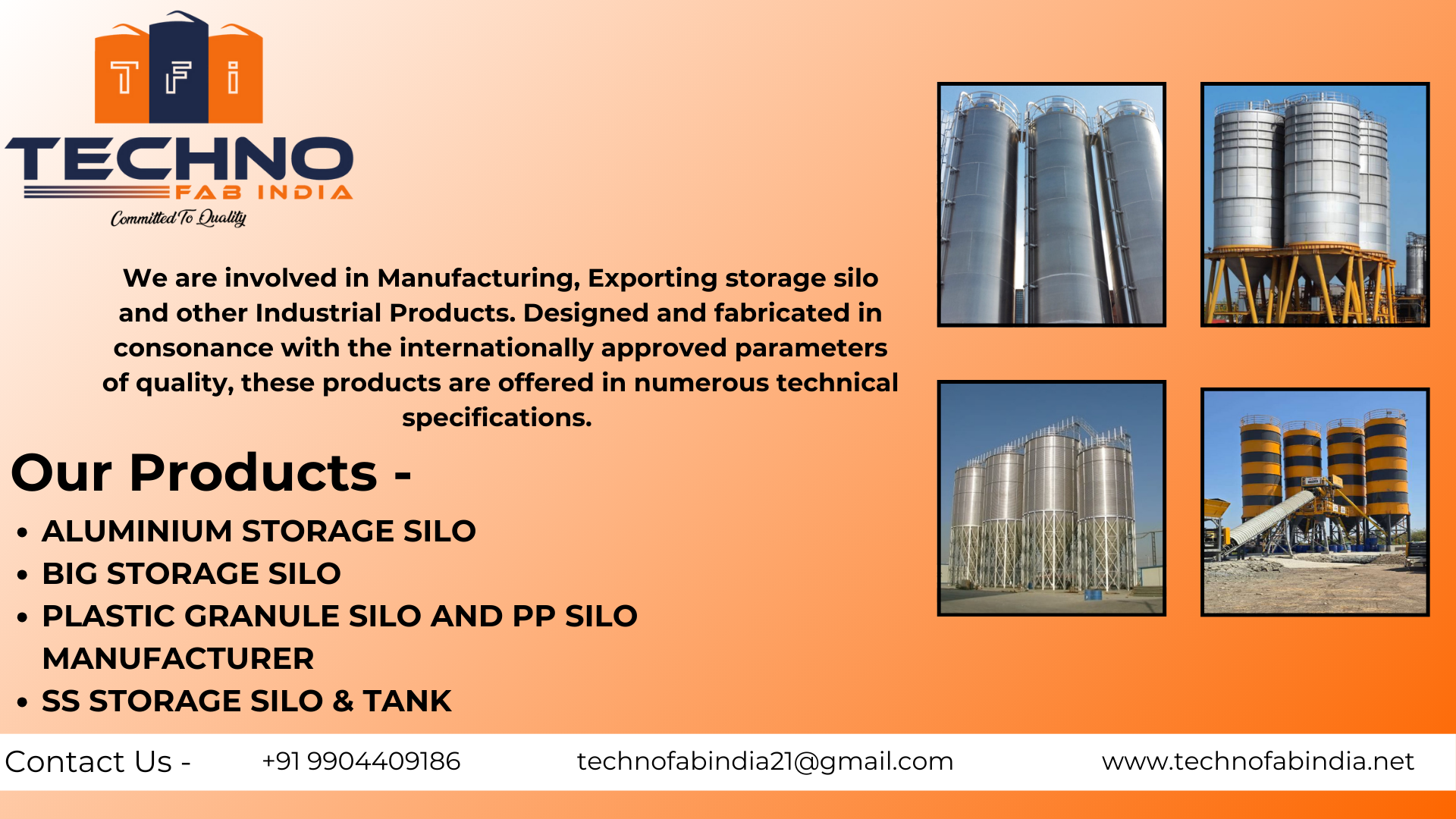
Vertical Silo
Vertical Silo
What is a Vertical Silo?
A vertical silo is a tall, cylindrical storage structure designed to store bulk materials like grains, cement, fly ash, animal feed, or other powdered and granular substances. These silos stand vertically to utilize minimal ground space and are built with materials such as mild steel (MS), stainless steel (SS), or reinforced concrete (RCC).
In India, vertical silos are widely used in agriculture, construction, manufacturing, dairy, chemical, and food processing industries.
Vertical Silo Price in India
The price of a vertical silo in India varies significantly depending on:
-
Material used (MS, SS, RCC)
-
Accessories (ladders, level indicators, feeding/discharge systems)
-
Customization
Indicative Price Range (Approx.):
-
5 MT to 10 MT capacity silo: ?1.5 lakh to ?4 lakh
-
20 MT to 50 MT: ?5 lakh to ?12 lakh
-
100 MT and above: ?15 lakh to ?30 lakh+
These prices are approximate and may vary depending on location, manufacturer, and design specifications.
How Vertical Silos Are Made – Manufacturing Process
-
Design & Engineering
-
A custom design is created based on required capacity, material type, and application (e.g., cement, grain, or feed storage).
-
Load-bearing calculations and structural integrity are carefully engineered.
-
-
Material Cutting & Shaping
-
Steel sheets or RCC components are cut, rolled, and formed into circular panels.
-
Cone (bottom) and dome (top) shapes are formed depending on the silo type.
-
-
Fabrication & Welding
-
The silo walls are welded together vertically.
-
Ladders, hatches, manholes, and outlet valves are attached.
-
-
Surface Treatment
-
Assembly & Erection
-
Silos are either assembled on-site or transported in sections and installed with cranes.
-
Foundation is prepared to support the load.
-
-
Accessories Installation
-
Ventilation, level indicators, discharge augers, and pressure relief systems are installed.
-
Where Vertical Silos Are Used
-
Agriculture: Storing grains, seeds, silage, fertilizers
-
Construction: Cement, fly ash, lime, sand storage
-
Animal Feed Industry: Raw material storage for feed production
-
Food Processing: Storing flour, sugar, salt, starch, etc.
-
Dairy: Milk powder and feed additives
-
Chemical Industry: Storing plastic pellets, chemicals, or powders
Key Features of Vertical Silos
-
High Storage Capacity in minimal ground space
-
Customizable Dimensions as per need
-
Weather-Resistant Construction
-
Sealed Environment to prevent contamination
-
Integrated Discharge Systems
-
Easy to Load/Unload
-
Ventilation and Pressure Control
-
Level Indicators and Monitoring Instruments
Importance of Vertical Silos in Indian Industry
-
Supports large-scale storage in agriculture, crucial for managing seasonal harvests.
-
Enables uninterrupted raw material supply in cement and chemical industries.
Facilitates bulk handling in automation and modern warehousing.
-
Supports food security and industrial efficiency.
Advantages of Using Vertical Silos
Space Efficiency: Occupies less horizontal space, ideal for land-constrained facilities
Cost-Effective Bulk Storage: Reduces packaging, labor, and logistics costs
Better Material Handling: Automated systems enable easy filling and discharge
Long-Term Storage: Weather-sealed and moisture-proof design preserves material quality
Operational Safety: Comes with safety valves, pressure relief systems, and ladders with cages
Scalability: Can be expanded with minimal changes to existing layout
Cleaner Operations: Reduces spillage, dust, and environmental exposure
Significance of Vertical Silos in India
-
With growing industrialization and farm mechanization, vertical silos are crucial to improving storage efficiency.
-
Helps in preventing post-harvest losses, especially in grain and feed storage.
-
Acts as a backbone for modern construction projects, enabling bulk cement/fly ash supply.
-
Aids in maintaining hygiene and compliance in FSSAI and ISO-certified food manufacturing units.
Why Choose Vertical Silos?
-
Compact and High-Capacity Design
-
Low Maintenance with Long Life
-
Essential for Agricultural Warehousing
-
Compatible with Automation
-
Safe and Reliable Storage Option
FAQs – Frequently Asked Questions
1. What capacities are available in vertical silos?
Capacities range from as low as 5 metric tons to over 500 metric tons, based on storage needs.
2. Which is better – steel or concrete silos?
-
Steel silos are faster to install and easier to relocate.
-
Concrete silos are better for permanent, heavy-duty applications with longer service life.
3. Do vertical silos require regular maintenance?
Minimal maintenance is required. Periodic inspections, repainting (for steel), and valve/lid checks are sufficient.
4. Can vertical silos be relocated?
Yes, modular steel silos can be dismantled and relocated. RCC silos are fixed structures.
5. Are vertical silos suitable for coastal areas?
Yes, but galvanized or stainless steel is preferred in coastal regions to prevent corrosion.
6. How is the material discharged from the silo?
Using gravity-fed hoppers, augers, pneumatic conveyors, or air slides, depending on material type.
Conclusion
Vertical silos are an indispensable part of India’s agricultural and industrial infrastructure. Their ability to store bulk materials efficiently, reduce losses, and enable streamlined operations makes them a valuable investment for any medium to large-scale operation.
From farmers storing grains to cement manufacturers ensuring continuous supply, vertical silos offer unmatched efficiency, safety, and scalability. Whether you are building a new facility or upgrading existing infrastructure, choosing a vertical silo means you're choosing modern storage for modern demands.
Gmail:-technofabindia21@gmail.com
Website:-https://technofabindia.net/
Quick Links
Our Products
Get In Touch
Plot No 4, Matruchhaya Ind Park, Nr. Kroma Paints, Dhamatvan-Vanch road, Dhamatvan Ahmedabad - 382440 Gujarat, INDIA.
technofabindia21@gmail.com
+91 9904409186
TECHNO FAB INDIA | All Rights Reserved.
